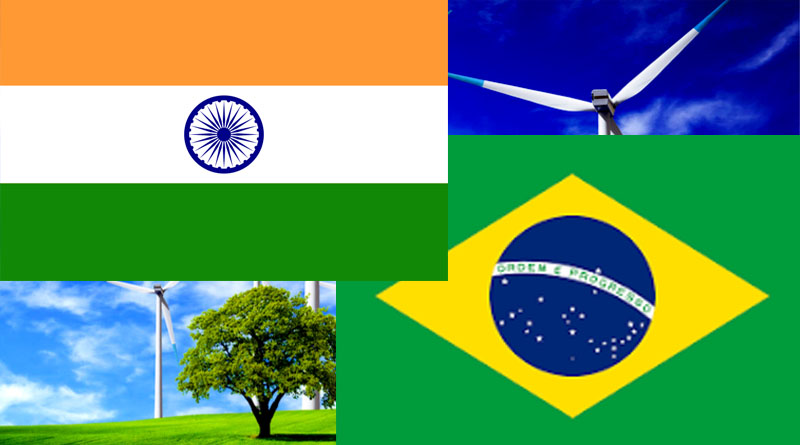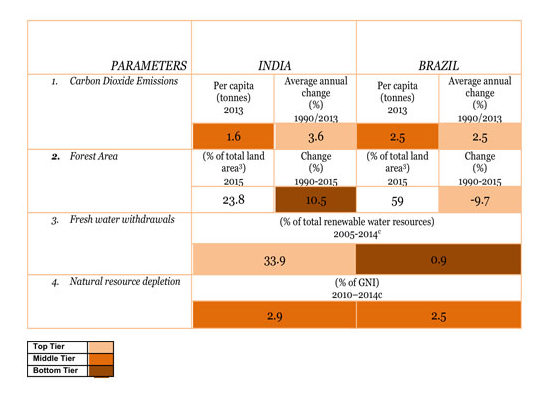



In our weekly bid to bring you a new country comparison with India based on the Human Development Report better remembered as the Human Development Index (HDI). This week our chosen country is all the way across the Atlantic, with Portuguese being the most widely spoken language in the region, the country we’ll be comparing India with is Brazil.
The article as whole aims at going beyond the numbers published in the report in the hopes to leave you, our readers better informed. As per the HDI ranking India ranks at 131 and Brazil ranks higher than us at 79. Let’s delve into the intricacies of the report, in order to gain a fresh perspective, we’ll look closely at the Environmental Sustainability factors of the Sustainable Development Index published in the report.
Brazil’s Renewable Energy Consumption is at 43.6% as compared to India’s 39%. Even though the difference might not seem much, Brazil ranks among the top tier countries in the world as compared to India who is in the middle tier. Brazil is one of the leading countries in the world to invest in Renewable sources of energy. With it’s abundant natural resources, 67% of Brazils power is from Hydroelectric projects, 9% from biomass/ natural gas, 8% from wind and the rest is from fossil fuels. Brazil has the ninth largest installed capacity for wind energy, spread over 466 farms it is estimated to produce 11,670 MW and it is investing further into wind energy as a primary source of energy. India on the other hand still derives most of its power from thermal plants even though it has recently started investing in solar, it still has a long way to go in order to catch up to Brazil.
Both the countries are in the middle tier when it comes to Carbon Emissions, though India beats Brazil at 1.6% as compared to Brazils 2.5%. Brazil however beats India in the annual change. Both the countries heavy investment in fossil fuels and rise in population has contributed to these figures. Brazil’s investments in renewables os how it beats India in the emissions annual change.
Brazil’s forest cover is one of the largest in the world with 59% of its landmass being covered by forests. India on the other hand has a forest cover of 23.8%. However, India’s latest efforts in preserving its forest reserves, has actually put it in the top tier countries in terms of change in forested area. Brazil on the other hand has seen a steep decline of -9.7% raising alarms all over the world. Brazil’s rate of deforestation increased by 30% in one year from august 2015 to 2016. Brazil is home to the amazons, which is essentially the “lungs of the planet”. The rapid decline in forest cover would affect the worlds eco-system. The governments increasing budget cuts in environmental protective issues has led to legal and at times illegal encroachment of land by locals and agriculturists. The projects to set up dams in the area for energy production are also a cause for the depletion of forested areas.
When it comes to fresh water withdrawals Brazil is again in the top tier countries with only 0.9% as its fresh water withdrawal rate as compared to India’s 33.9%. Brazil has the largest fresh water reserve in the world and with its average population density the withdrawal rates are extremely low. India’s large population and exaggerated use of groundwater on the other hand has depleted its fresh water reserves.
Lastly, when we compare natural resource depletion both the countries fall in the middle tier. Running a close race India’s natural resource depletion is at 2.9 as compared to Brazil’s 2.5. With India’s increase in renewable sources and Brazil’s increase in oil extraction and decline in forest cover, might make India catch up to or even surpass Brazil in terms of rate of natural resource depletion.
By: Aishwariya Chauhan
Publish on: Mar 26, 2018
The first unit of the Compressed Biogas Plant built by Reliance at the Peddapuram Industrial…
As Karnataka gains momentum in the direction of ‘waste to energy,’ the Mysuru City Corporation…
DCM Shriram Limited has announced that it has successfully commissioned a new Compressed Biogas (CBG)…
TKIL Industries has partnered with global biogas conglomerate KIS Group to advance the production of…
1. What is Awite and what does it have to offer to the Indian biogas…
The Indian Federation of Green Energy (IFGE) and the Embassy of Nepal have jointly organized…